Hakodate Ramen Shop: Ajisai


(Source: 食べログ)
Carefully selected ingredients from Hokkaido
All of the ingredients used in the soup for the shio ramen are produced in Hokkaido, including the kelp used in the shio ramen, the butter for the shoyu ramen, and the milk in the curry ramen. The soup takes a lot of time and effort to prepare as the heat level has to be just right for you to enjoy a rich flavour that is not bitter.

(Source: 食べログ)
Known for Hokkaido's speciality, shio ramen
This restaurant's most popular dish is the 'Misai Shio Ramen' (750 yen). Using pork, chicken, and natural rock salt on a base of kelp produced in southern Hokkaido, this soup is clear with no bitter taste, and is even popular among women. It also tastes excellent with the shop owner's special made-to-order straight noodles or with a juicy roast pork on top of the noodles.

(Source: 食べログ)
Mouth-wateringly spicy!
Using milk produced in Hakodate as a base, misai curry (880 yen), a type of curry ramen, has a mild spiciness and is very popular. A soup that sparks appetite with its perfect harmony between the spicy curry and mellow, rich flavoured milk.

(Source: 食べログ)

(Source: 食べログ)
Carefully selected ingredients from Hokkaido
All of the ingredients used in the soup for the shio ramen are produced in Hokkaido, including the kelp used in the shio ramen, the butter for the shoyu ramen, and the milk in the curry ramen. The soup takes a lot of time and effort to prepare as the heat level has to be just right for you to enjoy a rich flavour that is not bitter.

(Source: 食べログ)
Known for Hokkaido's speciality, shio ramen
This restaurant's most popular dish is the 'Misai Shio Ramen' (750 yen). Using pork, chicken, and natural rock salt on a base of kelp produced in southern Hokkaido, this soup is clear with no bitter taste, and is even popular among women. It also tastes excellent with the shop owner's special made-to-order straight noodles or with a juicy roast pork on top of the noodles.

(Source: 食べログ)
Mouth-wateringly spicy!
Using milk produced in Hakodate as a base, misai curry (880 yen), a type of curry ramen, has a mild spiciness and is very popular. A soup that sparks appetite with its perfect harmony between the spicy curry and mellow, rich flavoured milk.

(Source: 食べログ)






